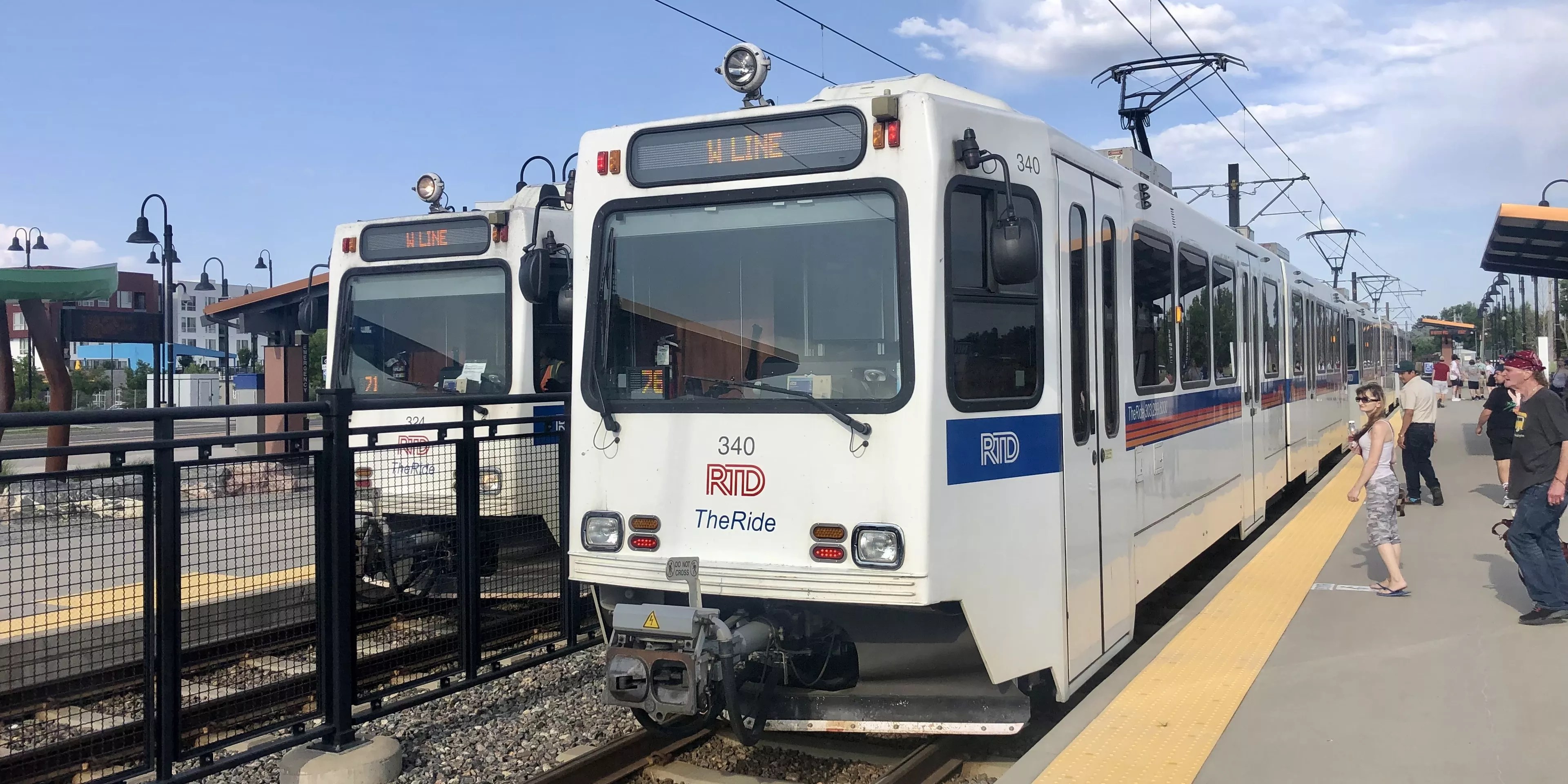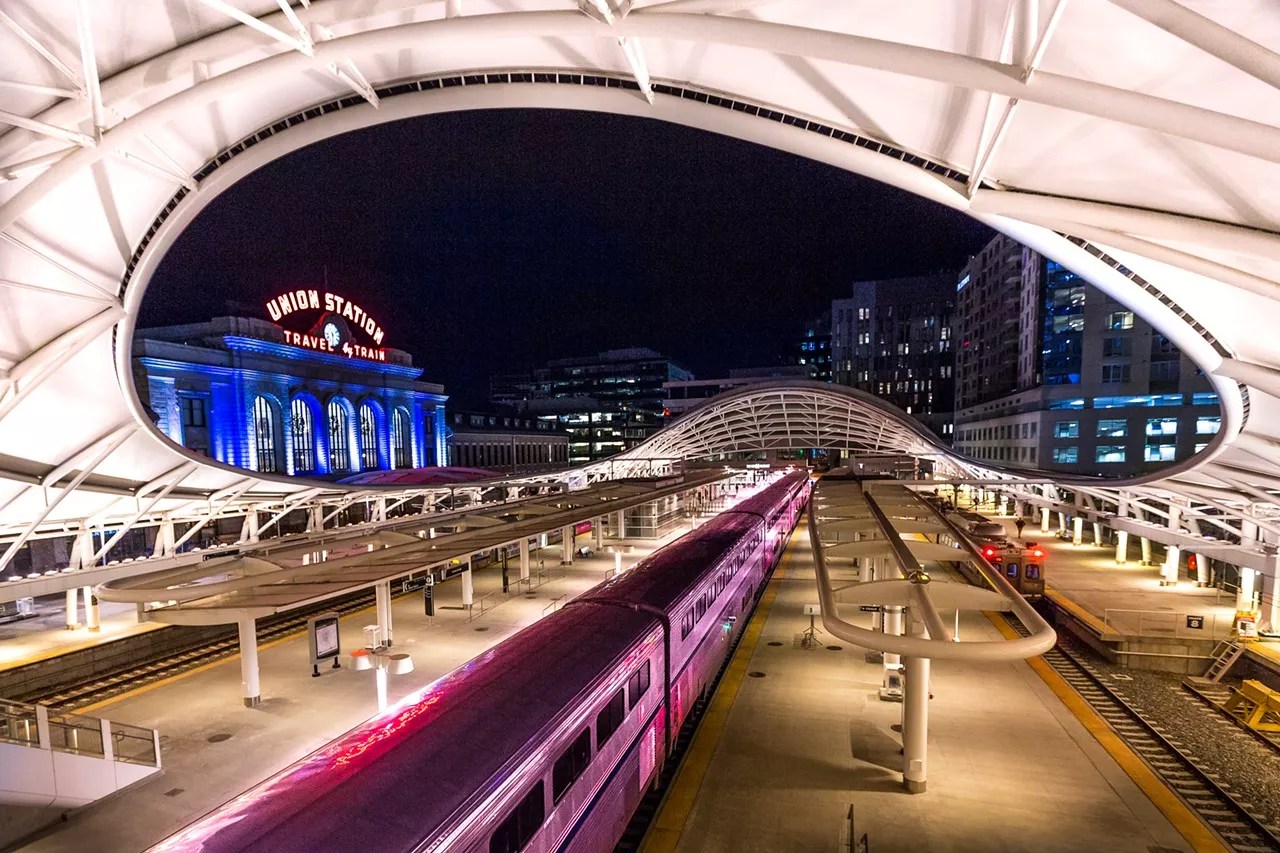
Westword

Audio By Carbonatix
A bill aimed at adding more passenger rail to Colorado is chugging along to becoming law.
SB24-184, Support Surface Transportation Infrastructure Development, passed the Senate Appropriations Committee on April 12 and will now be heard on the Senate floor. Sponsored by Senate President Steve Fenberg and Senator Janice Marchman with representatives Julie McCluskie and Andrew Boesenecker as the House sponsors, the bill would establish a congestion reduction fee on rental cars to generate matching funds for federal infrastructure money designated for new rail projects.
The bill would also clarify which projects money collected from tolls roads can fund while directing the Colorado Transportation Investment Office (CTIO) to invest in more statewide Bustang service and create a new plan for addressing greenhouse gas emissions in the transportation sector.
“We clearly need to invest more in our transportation system in the state,” Fenberg says, referencing his work in 2021 to fund more sustainability in the state’s transportation system. “This bill is about the same, but it’s about being a little bit more visionary and thinking about big infrastructure investments, specifically around multimodal transit.”
The proposal contemplates passenger rail from Denver to Fort Collins and a mountain rail system from Denver up to Craig and Hayden. The extra Bustang routes would help more rural areas of the state to connect through transit.
“It’s really important that people have travel options going around in the state, whether it’s to reduce pollution or just to give people a more convenient way to get from point A to point B so they don’t have to be stuck in traffic or, if they are in traffic, they’d be getting work done or just relaxing and leaving the driving to someone else,” says Danny Katz, executive director of the Colorado Public Interest Research Group, which supports the bill.
But to build these options, the state needs money – and that’s where the legislation comes in. It would establish a $3 per day fee on rental cars (which is reduced to $2 for electric vehicles). Money generated from the fees would be devoted to building out multimodal transit options and provide matching funds for federal dollars.
In 2021, a bipartisan infrastructure law set aside $66 billion for rail projects across the country, but local governments need to provide 20 percent of the funding for their projects to qualify. The estimated $50 million coming annually from the new fee would contribute to the 20 percent Colorado would need to pony up.
“It’s really important, I think, that we put in a good application and that we secure this moment where we can get partnership – and a significant amount of money – from the federal government for these projects,” Fenberg says. “If we don’t get them, some other state will. So I want to make sure Colorado gets more than its fair share.”
He says Colorado is currently on the low end of the average for rental car fees among the other states, and this fee would move it up to the high end of the average. With the right funding, Fenberg sees Colorado as very competitive compared to other states that will be applying for the available funding.
How Competitive Is Colorado for Federal Funds?
In fact, Colorado has already been selected by the federal Corridor Identification and Development Program for a phase II grant worth $500,000 to continue developing a plan to connect Fort Collins to Pueblo with passenger rail.
“We’ve sort of been given the signal from the federal government that they’re really excited about our project,” Fenberg says.

RTD’s light-rail projects could get some federal funding.
RTD
President Joe Biden’s administration is focused on increasing nationwide passenger rail, and Trinidad is a possible site for the connection of many cross-country rail lines. Having strong rail along the Front Range would help supplement the national goal, too, Fenberg says.
But according to Matt Frommer, senior transportation associate with the Southwest Energy Efficiency Project (SWEEP), proponents still have work to do. “It’s exciting to think about bringing that money to Colorado, but it doesn’t have to come here,” he says.
Areas like the Texas triangle and a Chicago-Milwaukee connection are also pushing projects with the federal government, Frommer notes. He’s hoping the Front Range Passenger Rail District, an organization set up in Fenberg’s 2021 bill to explore rail along Interstate 21, will create a convincing plan to show how the project can stimulate the economy and get a significant number of vehicles off the street.
“We need to demonstrate that it’s going to be a highly successful and utilized system in order to justify federal investment and make the project more competitive, which in my mind isn’t a slam dunk,” Frommer says.
SWEEP supports the bill and hopes it will be another component to getting the federal funding. Ean Thomas Tafoya, a longtime environmental advocate and Colorado director of the nonprofit GreenLatinos, adds that the idea is very popular among the community, which also makes it appealing to the federal government.
His organization is working to promote areas like Trinidad, Weld County and Greeley as potential locations for more passenger rail and Bustang service.
Funding Could Help FasTracks and Mountain Rail
But the focus for many is an RTD light-rail route from Denver to Longmont, which voters approved in 2004 as part of the FasTracks package that implemented a sales tax to fund more rail. However, the district has struggled to generate enough funding to implement many projects, including the Northwest Rail line that’s only about 50 percent completed, running to Westminster.
“Being a legislator from Boulder County, we’ve been waiting twenty years for the Northwest Rail line,” Fenberg says. “This is a way sort of get a shot in the arm for that project and create a path where we can actually get that done in the foreseeable future and do it in a way that’s faster, more efficient, and hopefully more affordable than we would be able to otherwise.”
The agency has said it may not be able to work on the project until at least 2035 without a change in funding. According to Katz, a few daily trains could run by 2028 if this federal funding comes through.
In a statement, RTD tells Westword it is tracking the progress of the bill.
“Currently, the agency is studying service options for commuter rail service between Westminster and Longmont and will continue to work closely with Front Range Passenger Rail and CDOT regardless of SB24-184’s outcome,” the statement notes.

The Amtrak Winter Park Express in Union Station.
Nicole Daniels
Despite the excitement for Front Range Rail, the bill isn’t designed just for that. The mountain rail line would connect communities from Denver through Winter Park up to the very top of the state. And it’s not just for skiers.
“I’m excited about mountain rail, too, because it’s helping us with the coal communities,” Tafoya says. “By bringing people access to public lands and other things, we can diversify their economies.”
According to Fenberg, the line could also help mountain towns generate tourist revenue; people could fly into Denver International Airport and hop on a train that would take them right to Steamboat Springs. It could also help those towns incur less pollution from people driving cars, he adds.
“The governor’s administration is seeing that they need to look to the transportation sector as a place where we’re going to hit our greenhouse goals and we’re going to be leaders on the planet,” Tafoya says. “Transit is really the best way to do it, because you can electrify all the cars you want and they’re still going to want to widen the highway.”
The bill addresses that conflict, too, by directing the Colorado Transportation Investment Office to explore using funds collected from toll lanes for projects that can reduce congestion that may not be directly on the highway itself once they pay back the money spent creating them.
“When you think about the future as we open more express lanes to collect more total revenue, we’re going to start collecting in the hundreds of millions of dollars,” Frommer says. “We want to make sure that money is available for projects that reduce greenhouse gas emissions and not just more highway lanes, and this bill would do that.”
Currently, the CTIO is technically allowed to fund large infrastructure projects that wouldn’t happen without express lane fees, but its project list has focused mainly on widening highways. According to Fenberg, the bill would let the CTIO know it’s expressly allowed to collect fees and invest in projects like more Park-and-Rides near transit that could help reduce congestion, which is the goal of toll lanes.
That section of the bill will likely be amended to clarify that it isn’t diverting resources from existing or planned projects, just giving the CTIO flexibility. The bill also instructs the office to create a new strategic plan to be more mindful of greenhouse gas emissions.
Aside from rental car companies that aren’t thrilled about the fees, most of the feedback on the bill has been positive, Fenberg says. Community advocacy groups have heard the same.
“By investing in transit, we’re giving ourselves the freedom to have more ways to get around, and there’s just huge benefits from reducing pollution, improving safety to avoiding traffic, that improve our quality of life,” Katz says.